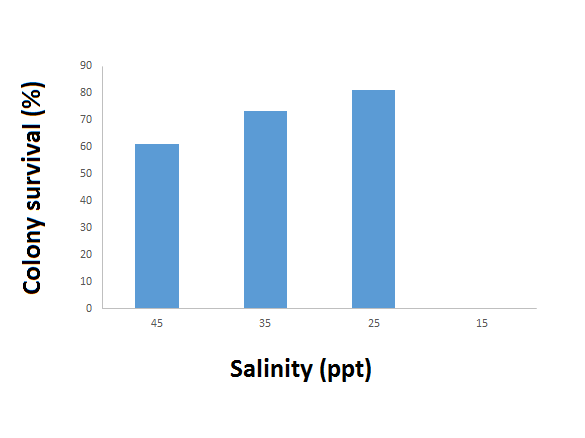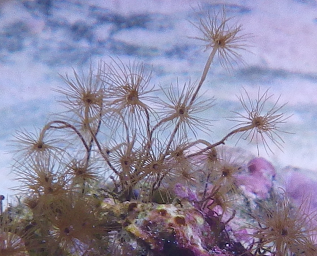Summary
Physical Description
Ecology
Life History & Behaviour
Hormesis Experiment
Anatomy & Physiology
Evolution & Systematics
Biogeographic Distribution
Conservation & Threats
References & Links | Experimental Investigation
There have been a number of studies investigating the phenomenon of ‘hormesis’ in Hydrozoa. This stipulates that when these organisms are exposed to low levels of toxins (copper, cadmium and reduced salinity) an adaptive response leads to increased growth (Stebbing 1981).
Methodology:
Four 37.5L aquarium tanks were set up, with salinites of 15ppt, 25ppt, 35ppt and 45ppt saltwater. In each tank, two colonies of Myrionema hargitti were attached to glass slides with a piece of modelling clay, positioned separately in an open plastic takeaway container and then placed at the bottom of the tank. In order to simplify the quantification process, colony sizes were limited to between 3 and 6 polyps connected by a stolon. The temperature, salinity and total number of polyps in each tank was recorded and maintained over the course of two weeks.
Findings:
The results obtained indicate a preference for the 25ppt conditions (low toxicity) over the control, 35ppt. Figure 6 illustrates the relationship between salinity and colony survival, calculated as a percentage of original colony size (Stebbing 1981).

Figure 6. The effect of salinity on the survival of Myrionema hargitti colonies.
As can be seen, while 25ppt yielded the greatest success, a decrease of 10ppt lead to complete toxification of the colonies with no surviving members. Additionally, increasing the salinity from 35ppt to 45ppt did not see an increase in survival, despite the low level of toxicity.

These results indicate that Myrionema hargitti would thrive in brackish water, demonstrating its capacity to colonise habitats of varying environmental conditions. As such, the phenomenon of hormesis can explain the success of Myrionema hargitti as an aggressive biofoulant and invasive aquarium pest.
|
|